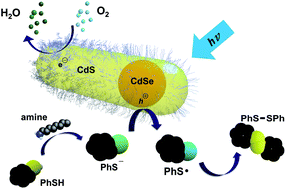Insights into the extraction of photogenerated holes from CdSe/CdS nanorods for oxidative organic catalysis†
Abstract
Using aerobic oxidative coupling of thiophenol in organic media as a model reaction, we show that photogenerated holes in CdSe/CdS core–shell nanorods can be efficiently extracted. As a result, CdSe/CdS nanorods can serve as an efficient visible-light photocatalyst at a very low concentration (∼1.5 × 10−4 mol%). We show that primary amines play an important role in the transformation of thiols into disulfides by forming a soluble thiolate in nonpolar solvent. Using time-resolved optical spectroscopy and electron paramagnetic resonance spectroscopy, we show that thiolate can efficiently extract the photogenerated holes from CdSe/CdS nanorods and transform into disulfide in organic solvent. Our data indicate that there are two reaction pathways responsible for S–S coupling of thiolate upon illumination of CdSe/CdS nanorods. We demonstrate that instead of scavenging of photogenerated holes by sacrificial species for prevention of photo corrosion of CdSe/CdS nanorods, the photogenerated holes can be efficiently used for oxidative organic synthesis.



 Please wait while we load your content...
Please wait while we load your content...